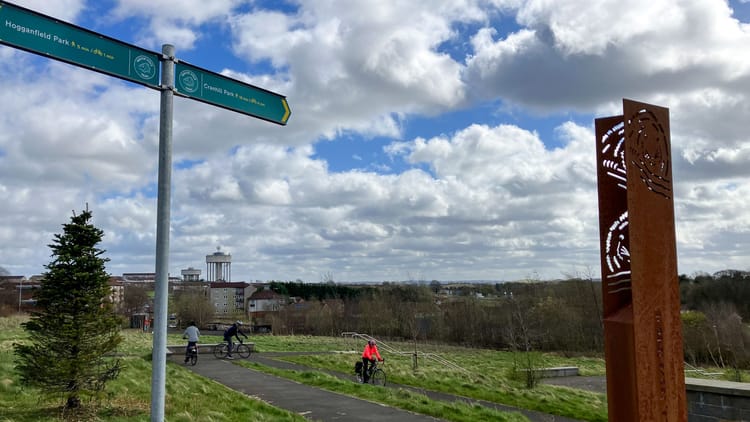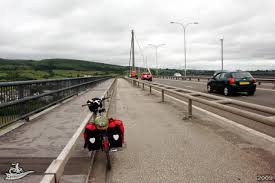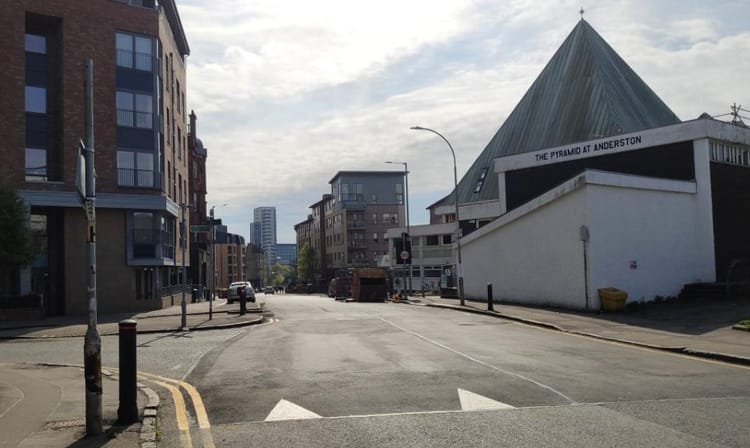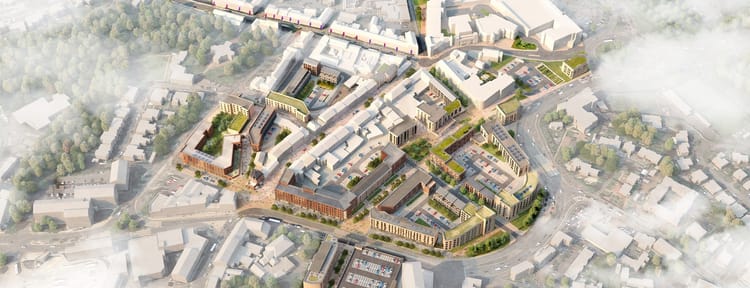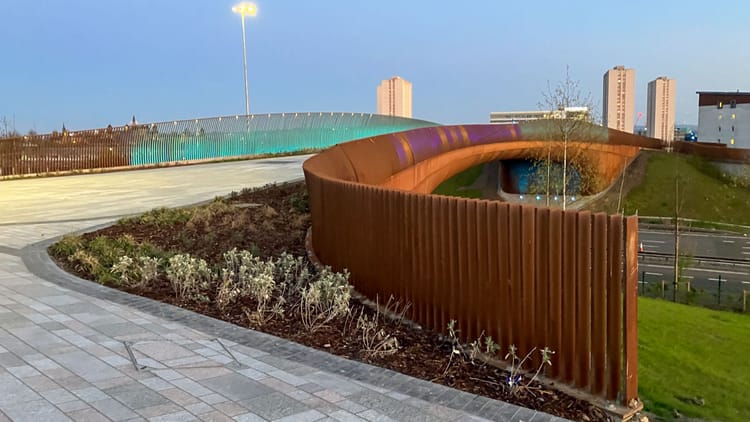Consultation Digest Issue 41, 20 August 2019: Promising news from East Renfrewshire and a Glasgow Avenues update.
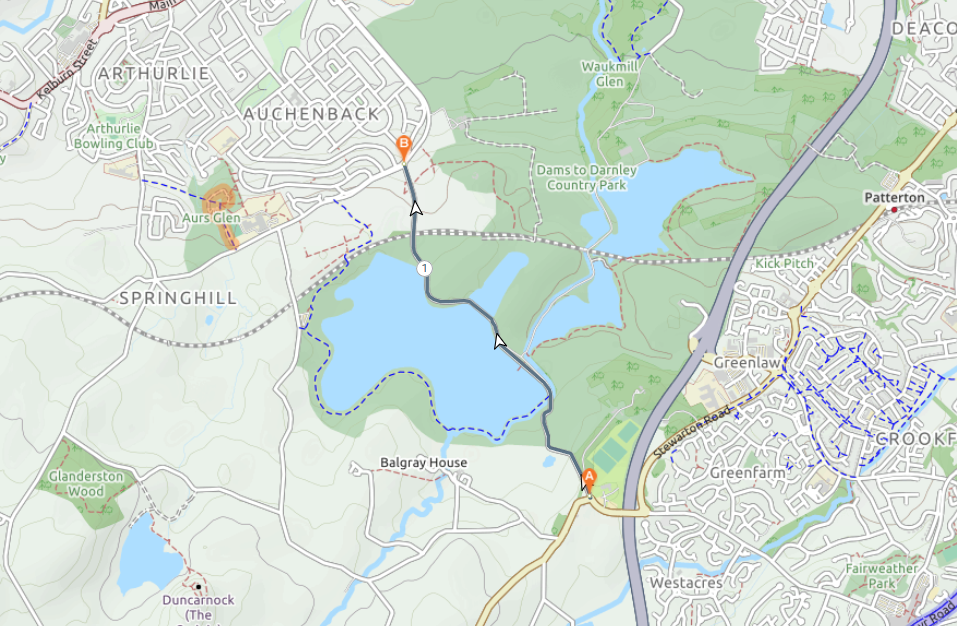
There is lots more in this Digest, with quite a bit of feedback again, including news from ScotRail and a reply to our objection to the painted cycle lanes proposed for University Avenue,
Contents
Section 1: Current Consultations
- Glasgow, St Enoch District Regeneration Framework Public Consultation, closes 06 September
- Glasgow, Connecting Woodside, St George’s Road and West Princes Street on-line consultation closes 13 September
- Consultation on Scotland's National Transport Strategy, closes 23 October
Section 2: Forthcoming Consultations
- Glasgow, Connecting Woodside, St George’s Road and West Princes Street consultation event 27 August
- Glasgow, Pollok Country Park - Project Update and Public Consultation Event, 22 August, NOW POSTPONED UNTIL 10 SEPTEMBER
Section 3: Consultation Feedback
- Glasgow, Avenues preview events for Renfrew, Killermont and North Hanover Streets, 06 August
- Glasgow, Construction work to start on University Place
- East Renfrewshire, Aurs Road Upgrade and Realignment Project - Information Session 13 August
- ScotRail Cycle Forum 15 August
- New cycling offences: an update from CyclingUK
- Glasgow City Council (North Kelvin, North Woodside and Woodlands)(Mandatory 20mph Speed Limit Zone) Order 201, GCC response to GoBike submission
- Glasgow, support for the ban on cars at school gates
- Glasgow, University Avenue and University Place, Traffic Regulation and Parking Controls Order, GCC response to GoBike objection
Section 1: Current Consultations, in date order for response
1.1 Glasgow, St Enoch District Regeneration Framework Public Consultation, closes 06 September

We are still working on this, which we first advertised in Digest 37, Item 1.7 and we will definitely have our response in the next Digest on Tuesday 03 September, just before the closing date.
1.2 Glasgow, Connecting Woodside, St George’s Road and West Princes Street on-line consultation closes 13 September
In our Consultation Extra on 12 August we gave the details for the two Consultation events, one last week on 15 August and one next Tuesday (see below, item 2.1 for more details). However, there is also on-line consultation so please do complete this: see the details here.
1.3 Scotland, Consultation on Scotland's National Transport Strategy, closes 23 October

We gave this link in Digest 40 and we will be working on the GoBike response straight after the submission for the St Enoch consultation. Do have a look and put your own views in; we need a greater focus on active travel and public transport and the more responses the better.
Section 2: Forthcoming Consultations
2.1 Glasgow, Connecting Woodside, St George's Road and West Princes Street Consultation Event Tuesday 27 August, 3-7pm
As per our Consultation Extra a week ago the City Council and Sustrans will be at Woodside Library on St George’s Road on Tuesday 27th August, from 3-7pm. Here's the link to the Connecting Woodside update with the details.
2.2 Glasgow, Pollok Country Park - Project Update and Public Consultation Event, 22 August, NOW POSTPONED UNTIL 10 SEPTEMBER
Despite our reports in the last 2 Digests, we received this message on 06 August, just after Digest 40 was issued that:
"As part of the Transforming Pollok Country Park project, Glasgow City Council and Glasgow Life are developing proposals to improve access to and within Pollok Country Park. Following a period of engagement, emerging proposals are now entering the pre-planning phase and will then form the subject of a planning application later this year.
Please find attached documents relating to the Proposal of Application Notice that was submitted today (6th August) for access proposals in Pollok Country Park.
As part of the pre-planning process, a consultation event will take place at Pollokshaws Library on the rescheduled date of 10th September from 12 noon – 8pm which you are welcome to attend and will allow the opportunity for comments.
Kind Regards,
Glasgow City Council/Glasgow Life"
Here are the four documents that are mentioned: Site Plan, the Exhibition Leaflet, the Proposal of Application Notice and the Letter of Invitation to Consultees.
Do try and get along to the event if you can; most of us go to, or through Pollok Park at times and the proposals do appear to be genuinely active travel friendly.
Section 3: Consultation Feedback
3.1 Glasgow, Avenues preview events for Renfrew, Killermont and North Hanover Streets, 06 August
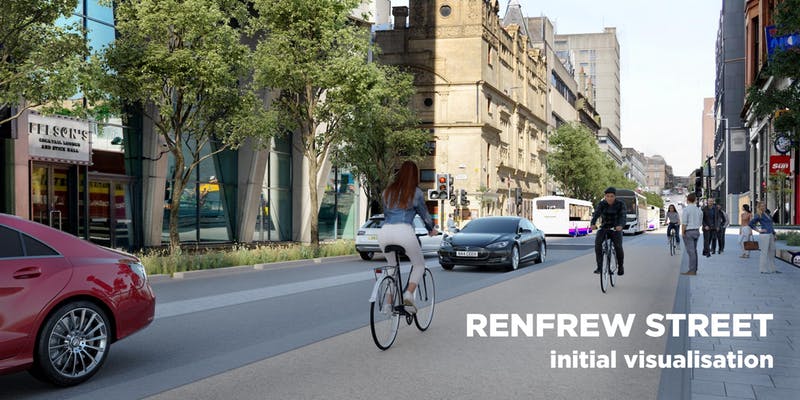
This event, held by Civic Engineers, who are carrying out the design work of this part of the City Deal Avenues project for Glasgow City Council, was well attended with good support for the proposals. The main points raised were:
- The aim is to normalise cycling; the main speaker was keen to say that the avenues are not for speed cycling.
- The amount of tarmac on the 16 core streets of the Avenues programme will be reduced, with swales and rain gardens introduced to absorb rain water - and to improve the environment.
- The project is in line with the aims of the Connectivity Commission, encouraging active travel for all abilities, reducing private car use in the city and encouraging use of public transport.
- The through cycle route along Sauchiehall Street will continue to Cambridge Street, then to Renfrew Street, Killermont Street and North Hanover Street.
- There will be no shared space.
- Discussions are taking place with SPT and bus operators about changing/reducing access to the bus station.
- The overall timescale is tight, but the tender package for Argyle Street (also part of the work being done by Civic Engineers) will be issued by the end of 2019 with work possibly starting as early as next spring.
- Questions asked by the audience included a request for contraflow cycling on connecting streets such as the one-way section of Renfrew Street at the west end, for traffic lights to be phased to give active travel priority and a concern that cars might use Townhead as a rat-run if access to North Hanover Street is reduced.
3.2 Glasgow, Construction work to start on University Place from 12 August
We know that cycling, and widespread consultation, was only an afterthought in a lot of Glasgow University's planning but here's some information that one of our members received on 05 August and passed on to us:
"Dear neighbour,
Please note that parking will be removed and barriers erected on University Place from Monday 12 August to allow for infrastructure and landscaping works through the University of Glasgow’s Campus Development Programme.
Construction will be ongoing until early 2021, to create a pedestrian and cycle priority route between Byres Road and University Avenue.
The works will also improve the look and feel of the environment, turning University Place into an accessible and attractive gateway for the new Western campus, including a small number of disabled parking spaces at its western end.
Parking on University Place is currently unrestricted and not covered by the University’s permit scheme.
Residents of University Place and staff requiring access to the underground car parks at the Wolfson Medical and BHF Sir Graeme Davis Buildings, staff of the NHS Pharmacy facility, as well as service and emergency vehicles, will still be able to access University Place.
The street will be open to pedestrians and cyclists during the works, and be one-way for cars, from University Avenue towards Byres Road.
The road will remain open to pedestrians and cyclists during the works. University Place will also be made one-way for cars, from University Avenue towards Byres Road.
Please see the plan for University Place works for more details.
Construction will start in August with drainage works at the West (Byres Road) end of University Place, working along the road towards University Avenue.
Later in the year, landscaping and resurfacing work will begin from the East (University Avenue) end of the road and work back along towards Byres Road. This work will complete in early 2021 in time for the opening of the Clarice Pears Building, which will house the University’s Institute of Health and Wellbeing.
Cycle racks, currently located outside the Wolfson Medical Building, will be relocated temporarily the Bower Building. Once complete, the landscaping for University Place will include over 100 cycle parking spaces.
The Next Bike facility will remain in its present location, however a new permanent location will be constructed nearby as part of the improvements.
Read more about the University’s Campus Development Programme
For any feedback please contact campus-development@glasgow.ac.uk"
One bit of good news in the above is that the one-way restriction applies only to cars, so University Place will remain two-way for people walking or cycling.
3.3 East Renfrewshire, Aurs Road Upgrade and Realignment Project - Information Session 13 August

GoBike was invited to this session and one of our members attended. Here is the feedback:
The scheme is being designed by Peter Brett Associates who have been given a wide brief to create not just a realigned road but an active travel route which will in time link into a visitor centre.
- The scheme is to realign Aurs Road from Springhill Rd to Stewarton Rd. Major bends will be removed and speed limits will be reduced from the current 60mph to 30 mph & 40 mph depending on location
- As yet not all funding is in place but there is expectation that funds will be located (e.g. from Sustrans) allowing the complete project as envisaged to be completed.
- It is planned that this is part of a larger overall redevelopment and to fit in with new housing north of the railway line and a visitor centre. There will also be a new 100place car park south of the Balgray Reservoir to allow folk access to the area.
- There is also talk of a new railway station, Barrhead South, north of Balgray Reservoir, to serve the new housing, but the likelihood/timetabling are very unclear.
- The essence of the plan is to take the bends out of the road, reduce the speed limit to 30/40mph and provide lighting. If they did nothing else the cycling environment would be greatly improved, particularly in winter. They also plan a cycleway and footway to the west of the existing road. For most of the length these will be segregated and in the case of the cycleway up to 3m in width. In some areas, in particular near the area of the proposed car park, limitations of space mean that shared space is inevitable. Space over much of the length is certainly a problem and to get the cycleway built means building a boardwalk over the edge of the reservoir itself. All very ambitious. Note that the cycleway will be lit.
We have some concerns, particularly about the start and end points and will be following them up.
Note that planning permission has not yet been sought. Once this has happened the plans will go on line.
The hope is to tender in the next 2-3 months with works starting in April 2020. The road will be closed in its entirety and the works will take (at least?) a year to complete.
The presentation given at the event is here.
3.4 ScotRail Cycle Forum 15 August
ScotRail hold their Cycle Forum two or three times per year and GoBike was represented at the most recent, held in Glasgow on 15 August. The main points of interest were:
- From May 2020 dedicated cycle carriages will be added to the formation of trains where there is mandatory booking, starting with Glasgow to Oban, followed by Glasgow to Fort William and Mallaig and then the Far North Lines.
- ScotRail have a Cycle Fund which awards match funding to such projects as improving cycle access to railway stations. GoBike is hoping to meet with ScotRail and Sustrans, and eventually the City Council, to explore improving links to stations in Glasgow.
- ScotRail is to review its policy on the carriage of electric bikes, which are currently officially banned on all UK trains because of concern about the batteries! It was suggested at the meeting that owners are probably unaware of this policy and load them onto trains anyway.
- ScotRail is reviewing its cycle hire scheme in light of usage and other schemes in operation.
- There is ongoing concern about the carriage of bikes on HSTs to intermediate stations that are unstaffed.
- Generally the carriage of bikes works well.
3.5 New cycling offences: an update from Cycling UK
Last September, in Digest 17, Item 1.8 we informed you of "Open Consultation from the UK Government, Department of Transport, New Cycling Offences, Causing Death or Serious Injury while Cycling". Cycling UK were quick off the mark to submit opposition to the proposals and GoBike supported the move, calling for a complete overhaul of road traffic offences.
Many of us who are individual members of Cycling UK added our voice and the following update was received on 07 August:
"Last autumn, the Government launched a consultation on new cycling offences.
You were one of over 13,000 people who supported Cycling UK and called on Government to stop tinkering around the edges and, instead, to launch the wholescale review of road traffic offences first promised in 2014.
Ten months on, we’ve finally had some news.
Last month’s Road Safety Statement listed 74 upcoming actions to improve road safety and, interestingly, plans to introduce new cycling offences were not included. Instead there was an acknowledgement that this is “a complex area” and that the Government is “considering bringing forward legislation to deal with this”.
Although this may seem insignificant, and we wouldn’t suggest reading too much into it, it’s a shift in position from the infamous announcement from the Conservative twitter account last year announcing that they were “cracking down on dangerous cyclists”.
So, let’s just say we’re more optimistic than we were this time last year – and that’s thanks to you, and 13,000 others, taking the time to write to the Government and your MP.
With Parliament on summer recess, and a new Transport Minister recently appointed, we’ll be sure to keep you updated as things develop over the coming months.
In the meantime, the urgent issue for cycling is the upcoming Government spending review: cycling needs more investment to ensure it's safer and more widely accessible.
Please support our campaign for cycling funding by writing to Chris Heaton-Harris, the new Minister responsible for cycling.
Duncan Dollimore
Head of Campaigns
Cycling UK"
Those of us fortunate enough to live in Scotland do not have a new Transport Minister, so if you do wish to ask the Scottish Government for more cycle funding do please contact Michael Matheson, Cabinet Secretary for Transport, Infrastructure and Connectivity.
3.6 Glasgow City Council (North Kelvin, North Woodside and Woodlands)(Mandatory 20mph Speed Limit Zone) Order 201
GoBike support for this move, with the concern about the city's patchwork approach to implementing 20mph across the city, was given in Digest 39, Item 1.5 and here's the response we received on 08 August.
There's a lot of detail about how the zone will be applied but still no recognition of the speeding that clearly occurs on streets that are already 20mph, eg the Broomielaw and the High Street.
"THE GLASGOW CITY COUNCIL, (NORTH KELVIN, NORTH WOODSIDE AND WOODLANDS), (MANDATORY 20MPH SPEED LIMIT ZONE) ORDER 201_
Thank you for your correspondence regarding the above named Traffic Regulation Order, your comments have been noted.
I can advise that the funding has been made available through Sustrans’ Places for Everyone programme funded by Transport Scotland as part of the Connecting Woodside project to introduce mandatory 20mph speed limit zones within the residential areas.
The 20mph speed limit zones will be signposted according to the TSRGD 2016 and there will be triangular lamp-post wraps prior to the 20mph speed enforcement coming into effect to notify the public of the new speed limits in the area.
I refer to the extremely positive change in regulations outlined in the recent Transport Scotland document titled the ‘Good Practice Guide on 20mph Speed Restrictions’. Whilst this guidance allows certain areas to be considered without physical traffic calming measures, unfortunately the council are unable to make the full council boundary a mandatory 20mph speed limit zone at this time. This would require substantial funds given the sheer volume of work that would require to be undertaken such as speed surveys, material costs and physical traffic calming measures required throughout the council boundary, particularly on existing roads with existing speed limits of 40mph and above.
The Police are included in the consultation process when a 20mph zone is being introduced. However, following Transport Scotland guidance and by introducing traffic calming measures where speeds are above 24mph, it is intended that the zones are mainly self-enforcing. Indeed, during discussions with Police Scotland Officers, they have indicated that they support the Council’s traffic calming policy. The Council has no direct input into where and when the police carry out enforcement.
Your support will be considered and included within the final report which will inform the decision. Once a decision has been taken in regards to these proposals I shall write to you again and advise of the outcome.
Yours sincerely
Steven Gray
Assistant Group Manager (Sustainable Transport)
Neighbourhoods and Sustainability"
3.7 Glasgow, support for the ban on cars at school gates
In Digest 34, Item 1.3, we published the proposals for banning cars from accessing close to the gates of six primary schools in the city. This has now achieved the support of Evening Times readers, see: https://www.eveningtimes.co.uk/news/17832845.car-ban-glasgow-primary-schools-city-backing/?ref=ebln
Let's hope now that the practice is spread to all schools across the city and beyond.
3.8 Glasgow, University Avenue and University Place, Traffic Regulation and Parking Controls Order, GCC response to GoBike objection
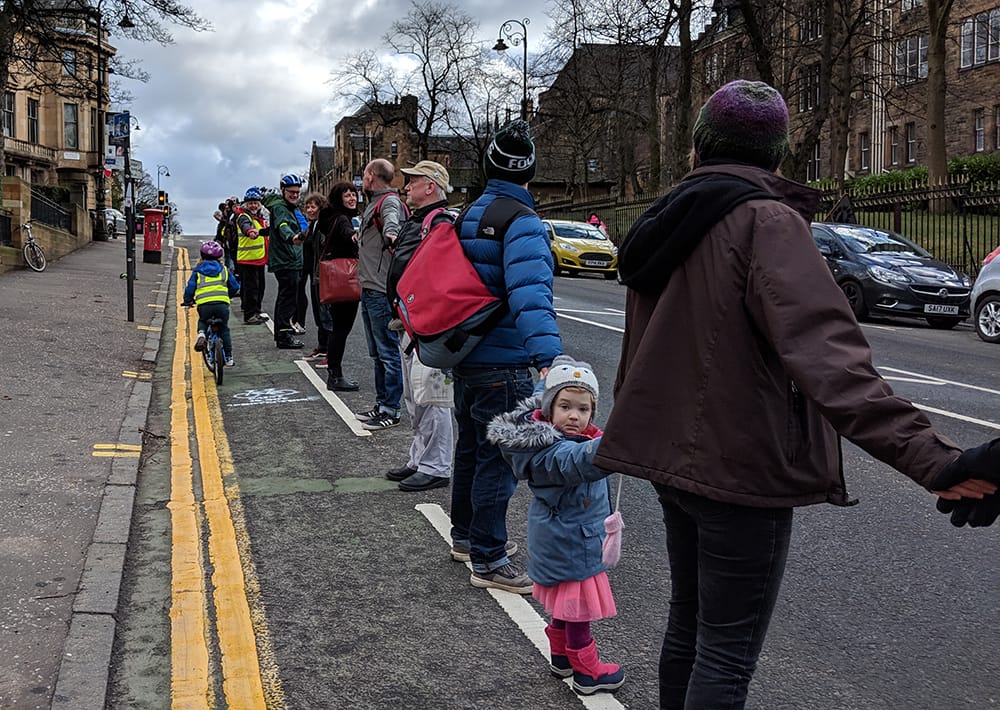
Many of you will remember the demonstration we had in February to demonstrate that painted cycle lanes offer no protection to people trying to cycle over the hill that is University Avenue and we submitted this letter of objection in June to the City Council.
We received this response on 13 August:
"MESSAGE SENT ON BEHALF OF ANDY WADDELL, DIRECTOR OF OPERATIONS, NEIGHBOURHOODS AND SUSTAINABILITY
Dear Ms Fort
THE GLASGOW CITY COUNCIL, (UNIVERSITY AVENUE AND UNIVERSITY PLACE), (TRAFFIC REGULATION AND PARKING CONTROLS) ORDER 201_
Thank you for your correspondence regarding the above named Traffic Regulation Order.
With regards to your concerns:
The University of Glasgow’s proposals for University Avenue and University Place were developed in consultation with Council officers and following consideration of all options available, including the incorporation of segregated cycle lanes in University Avenue and the introduction of bus gates at either end of the Avenue.
Options investigated the requirements for pedestrians, cyclists, public transport provision, University and local access issues and wider traffic management issues in line with the established hierarchy.
The resultant proposal significantly improves pedestrian passage both along and across University Avenue and has removed all existing parking. However, it was necessary to accommodate public transport routes in both directions as well as larger bus stops at the University. The two way traffic corridor will also accommodate emergency service vehicles and local service access. To mitigate other traffic access, a supporting Traffic Regulation Order will reduce the speed limit to 20mph. More severe traffic restrictions e.g. bus gates, were found to have a detrimental impact on adjacent streets such as Byres Road and were therefore discounted.
Unfortunately, due to land availability, local topography and a number of listed structures, it was not practicable to accommodate fully segregated cycle lanes in both directions. This is demonstrated in your own proposals which resulted in a single 3m one-way traffic lane and would not be supported by the Council, and would be likely to raise objections from other stakeholders including emergency services and bus operators. When considering the 20mph speed limit, the need to accommodate bus stops for large numbers of passengers and the sharp gradients, up to 8%, and campus cycle access available at either end of University Avenue, it was concluded that the mandatory cycle lanes would be provided only on the uphill sections.
The University has also taken a number of steps to improve the local campus environment for pedestrians and cyclists. The campus will be opened up with a number of signed routes, routes will remain accessible after hours. Car parking on the campus will be significantly reduced and other vehicle access controlled. Public realm including cycle storage facilities will be improved.
Addressing your specific observations:
1. The painted cycle lanes are dangerous.
Painted lines are a recognised means of cycle lane provision. It is noted that they are not ideal but they are the best that can be practicably achieved in this particular location. The university will investigate the practicability of introducing forms of light segregation, however there are concerns that this in turn may introduce a trip hazard.
2. The design of the painted cycle lanes within the TRO makes cycling even more dangerous.
Bus stops are located on either side of the crossing at the junction with Hillhead Street and, as there was insufficient road width to provide lay-bys, without the loss of pedestrian space, this made any opportunity to provide cycle lanes over the entire length of University Avenue impracticable.
The designers were required to work within the bounds of the existing public road limits. Unfortunately, as noted above, segregated cycle routes cannot physically be accommodated in both directions. Due to the grades it was determined that segregated cycle lanes on the downhill sections would be a greater risk due to the lack of width and proximity of pedestrians on narrower footways.
3. Painted cycle lanes on University Avenue do not prevent waiting, loading or parking.
The formalisation of the cycle lane means that if a vehicle crosses over the solid white cycle lane for any reason – for example, to drop off a passenger - they are in contravention of the Highway Code and this would be a police enforcement matter.
Practically, a vehicle stopping for any reason would block the carriageway and would be likely to be moved on by other road users. Equally a segregated lane would not completely deter dropping off activities.
4. The plans are in contravention of the Transport Hierarchy.
The plans are in accordance with the Transport Hierarchy as they prioritise pedestrian safety above all others by widening the footways and improving crossing facilities. It is necessary to maintain the route for two-way public transport, and private vehicle use has been affected with the removal of all parking spaces on University Avenue as well as the reduction to a 20MPH speed limit zone. Whilst full segregation has not been provided, the reduced speed limit and removal of vehicle parking spaces will benefit cycling. These measures are consistent with Cycling by Design.
Cycling by Design (2010) Hierarchy of Measures, "It should be recognised that measures are more easily accepted and implemented if they directly benefit the wider community, not simply existing cyclists. Strategies that emphasise safety in terms of motorised traffic restraint and speed reduction while promoting health and sustainability will aid the development of cycling."
5. The plans fail to recognise Climate Change Emergency status.
University Avenue has to maintain accessible for public transport in both directions. Modelling was carried out on potentially making University Avenue a bus only route; this was not feasible due to the level of disruption that would be created on Byres Road, Great Western Road and Dumbarton Road, and the associated side streets in the area. Similarly, a one-way street would not be possible either.
6. The plans fail to recognise recommendations made within the Connectivity Commission Report.
Policies can only be applied within the context of the local situation and if delivery is reasonably practicable in terms of issues such as physical aspects, user priorities, essential requirements and wider cost implications. Where you are seeking to adapt an existing streetscape it is not always possible to accommodate all aspirations in one situation. In the case of University Avenue, the reasons why it was not feasible to reallocate road space in strict accordance with the user hierarchy -which would see a larger portion of the road being dedicated to cyclists - are derived from the presence of physical constraints (level change, gradient and pinch point) which, if a segregated route was to be introduced, would compromise the safety of the most vulnerable road users i.e. pedestrians.
8. Double yellow lines with kerb marked lines are not legally compatible with mandatory cycle lanes.
The double yellow line marking restrictions apply from the heel of the footway to the centre of the carriageway. As previously mentioned, the solid white line marked cycle lanes are the boundary in which a vehicle cannot cross over. A vehicle is still within their right to drop off a passenger without crossing over the white solid line marked cycle lane. Any form of waiting beyond the reasonable amount of time for a passenger to board or alight is a traffic offence.
Glasgow City Council do not have a policy on the use of red line markings; there is potential for future implementation around the city with red line markings, however, the policy would have to be created to allow for this.
9. The TRO drawing is inconsistent with other approved planning drawings.
Whilst the omission of the drop off lay-by on the TRO drawing is noted it does not affect the actual restriction. The lay-by is for drop off only and parking would be an offence as it would on the rest of the carriageway.
10. Lack of public support.
The TRO process allows the public to formally object to the proposals and I can advise that the Council received 26 formal objections to the TRO. Several of these objections were supportive of the 20 mph speed limit.
Considering that staff and students of the university alone amount to almost 40,000 people, a figure increased significantly when considering local residents and businesses in the Hillhead / Byres Road area, the level of objection is relatively low in terms of other TRO consultations.
Having considered the above, should you wish to withdraw your objection I would be pleased if you would inform me by 3rd September 2019 by writing to Andy Waddell, Director of Operations, Neighbourhoods and Sustainability, House, Glasgow City Council, 231 George Street, Glasgow, G1 1RX or by e-mail to land@glasgow.gov.uk
If you do not wish to withdraw your objection then there is no requirement for you to write to us again.
Your objection will be considered and included within the final report which will inform the decision. Once a decision has been taken in regards to these proposals I shall write to you again and advise of the outcome.
Yours sincerely" etc
Needless to say we are not favourably impressed, we will not withdraw our objection on the strength of this response and might even reply to the City Council.

